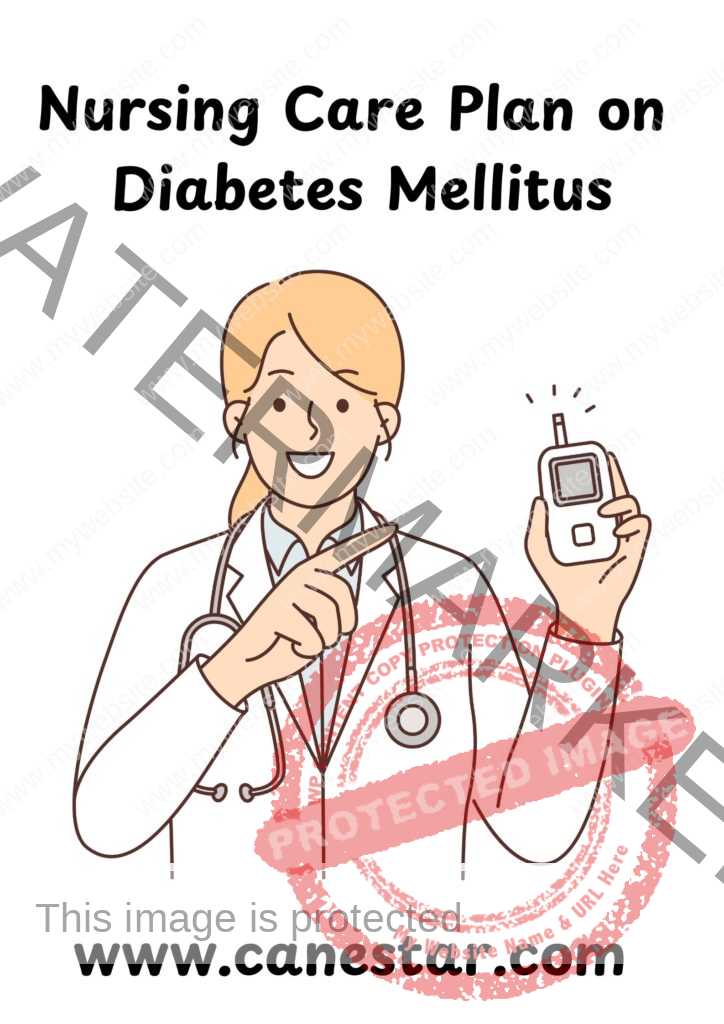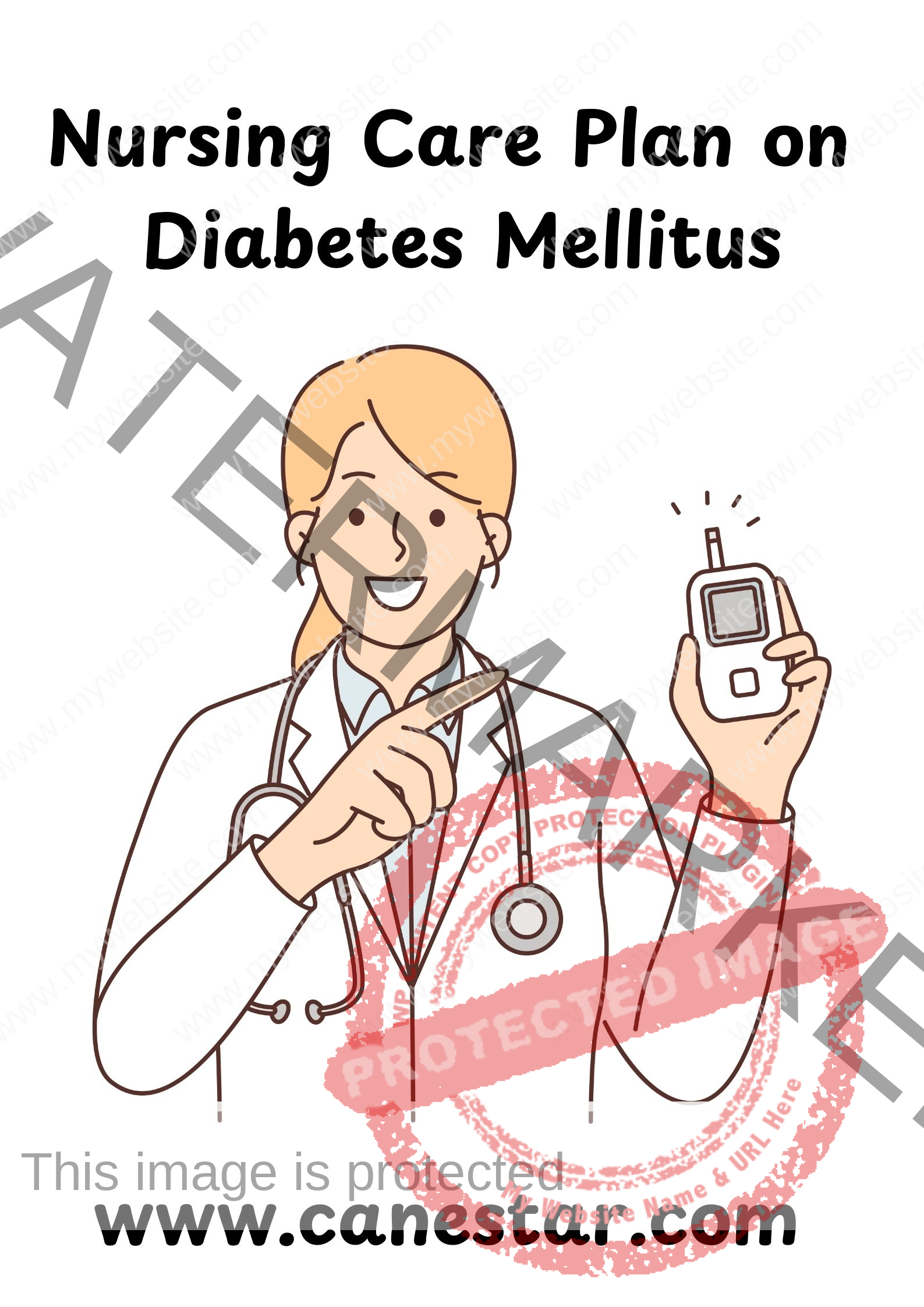NURSING CARE PLAN ON DIABETES MELLITUS
NURSING CARE PLAN ON DIABETES MELLITUS
Definition: Diabetes mellitus (DM) is a chronic metabolic disorder characterized by elevated blood glucose levels (hyperglycemia) resulting from defects in insulin production, insulin action, or both. Insulin, a hormone produced by the pancreas, is essential for glucose uptake by cells to provide energy.
Types of Diabetes Mellitus:
- Type 1 Diabetes Mellitus (T1DM):
- Autoimmune destruction of insulin-producing beta cells in the pancreas.
- Usually diagnosed in children and young adults.
- Patients require lifelong insulin therapy.
- Type 2 Diabetes Mellitus (T2DM):
- Characterized by insulin resistance and relative insulin deficiency.
- More common in adults, especially those with obesity, sedentary lifestyle, and genetic predisposition.
- Managed with lifestyle changes, oral hypoglycemic agents, and sometimes insulin.
- Gestational Diabetes:
- Occurs during pregnancy when the body cannot produce enough insulin to meet the increased demand.
- Typically resolves after childbirth but increases the risk of developing T2DM later in life.
- Other Specific Types:
- Diabetes can also result from genetic defects, diseases of the pancreas, infections, or medications (e.g., corticosteroids).
Nursing Care Plan for Diabetes Mellitus
Nursing Diagnosis 1: Deficient Knowledge Related to Disease Process and Management
Assessment Data:
- Patient reports confusion about blood glucose monitoring and insulin administration.
- History of poorly controlled blood sugar levels.
Goal:
- Patient will demonstrate understanding of diabetes management by correctly performing blood glucose monitoring and insulin administration within 48 hours.
Nursing Interventions:
- Assess the patient’s knowledge of diabetes, including blood glucose monitoring, diet, exercise, and medication regimen.
- Provide education on the disease process, importance of blood glucose control, and long-term complications (e.g., neuropathy, retinopathy, cardiovascular disease).
- Demonstrate the correct technique for blood glucose monitoring and insulin administration, allowing the patient to perform a return demonstration.
- Discuss the importance of adhering to the prescribed diet, including the role of carbohydrates and the need for regular meals to avoid hypoglycemia or hyperglycemia.
- Encourage regular physical activity appropriate to the patient’s health condition to enhance insulin sensitivity and improve glycemic control.
- Provide written materials on diabetes management and available community resources, such as support groups.
Evaluation:
- Patient is able to correctly monitor blood glucose and administer insulin.
- Patient verbalizes understanding of the need for dietary control and regular activity.
Nursing Diagnosis 2: Imbalanced Nutrition: More than Body Requirements Related to Sedentary Lifestyle and Poor Dietary Habits
Assessment Data:
- Body mass index (BMI) above normal range.
- Reports of consuming high-calorie, high-fat diet.
Goal:
- Patient will demonstrate weight reduction or stabilization and improved dietary habits within 4 weeks.
Nursing Interventions:
- Assess the patient’s current dietary habits and knowledge of appropriate nutrition for diabetes.
- Collaborate with a dietitian to develop a personalized meal plan that focuses on reducing calorie intake and improving food choices, including low glycemic index foods.
- Encourage the patient to keep a food diary to track daily intake and promote accountability.
- Educate on the relationship between diet and blood glucose levels, emphasizing the importance of portion control and healthy food options.
- Encourage regular exercise, starting with low-impact activities (e.g., walking) and gradually increasing duration and intensity as tolerated.
- Monitor weight weekly to track progress and adjust the plan as necessary.
Evaluation:
- Patient reports improved dietary habits and demonstrates a decrease in weight or BMI.
- Blood glucose levels are within target range more consistently.
Nursing Diagnosis 3: Risk for Unstable Blood Glucose Levels Related to Insufficient Insulin or Oral Hypoglycemic Agents
Assessment Data:
- History of frequent hypoglycemic or hyperglycemic episodes.
- Blood glucose levels fluctuate widely.
Goal:
- Patient will maintain blood glucose levels within the target range as prescribed by the healthcare provider.
Nursing Interventions:
- Monitor blood glucose levels as ordered, and report significant fluctuations to the healthcare provider.
- Educate the patient on the signs and symptoms of hypoglycemia (e.g., sweating, shakiness, confusion) and hyperglycemia (e.g., excessive thirst, frequent urination, blurred vision).
- Provide education on adjusting insulin or oral medication doses according to blood glucose levels, food intake, and activity levels as directed by the provider.
- Teach the patient to carry a source of fast-acting glucose (e.g., glucose tablets or juice) at all times in case of hypoglycemia.
- Collaborate with the healthcare team to adjust insulin or oral hypoglycemic agents based on blood glucose monitoring results.
Evaluation:
- Patient’s blood glucose levels remain stable within the prescribed range.
- Patient is able to recognize and manage early signs of hypo- and hyperglycemia.
Nursing Diagnosis 4: Risk for Infection Related to Hyperglycemia and Decreased Immune Function
Assessment Data:
- History of recurrent infections (e.g., urinary tract infections, skin infections).
- Poorly controlled blood glucose levels.
Goal:
- Patient will remain free from infection during hospitalization and after discharge.
Nursing Interventions:
- Monitor for signs of infection (e.g., fever, redness, swelling, pain, or discharge from wounds).
- Educate the patient on proper hygiene, including regular handwashing and foot care, to reduce the risk of infections.
- Instruct the patient to inspect the skin and feet daily for any signs of injury or infection and report abnormalities promptly.
- Encourage blood glucose control, as hyperglycemia can increase the risk of infection.
- Administer antibiotics as prescribed and monitor for side effects.
Evaluation:
- Patient remains free from infections.
- Blood glucose levels improve, reducing the risk of future infections.


